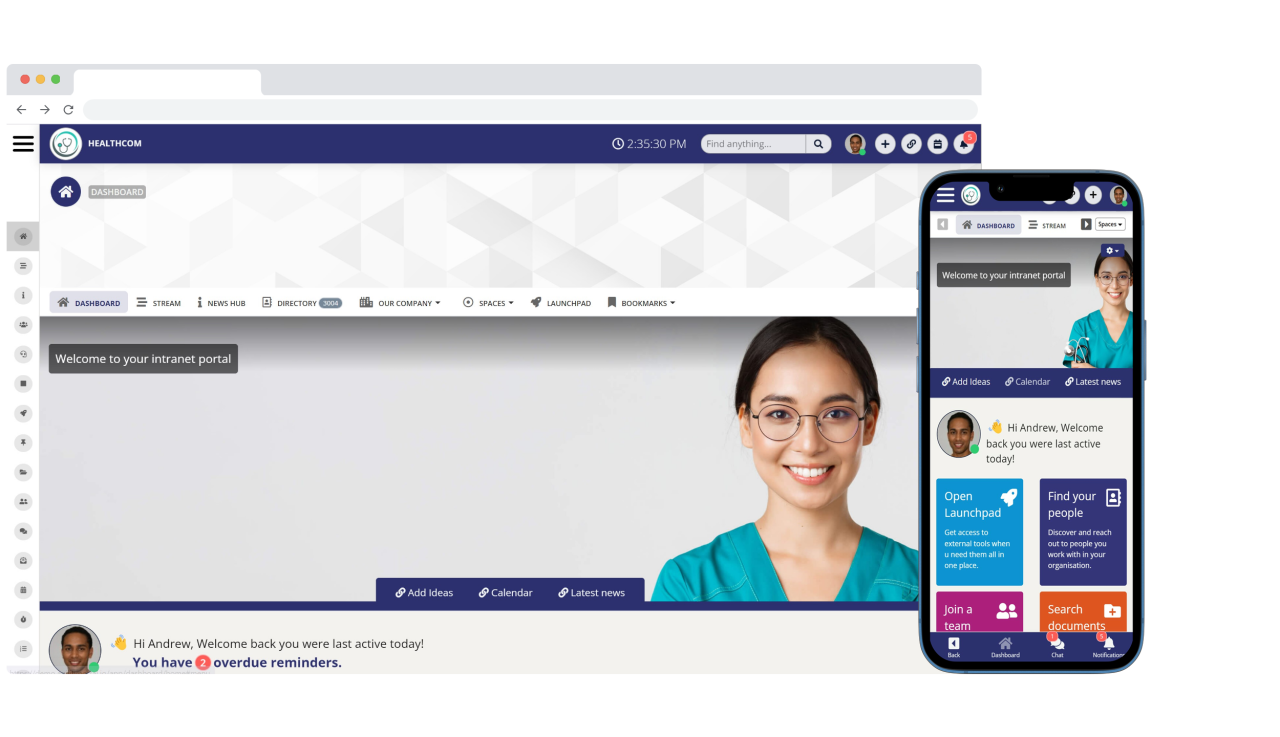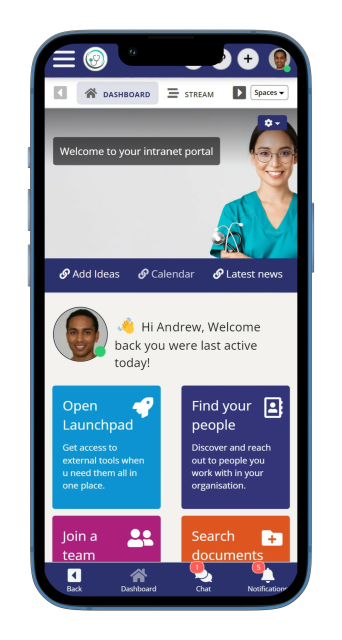Insight Blog
Agility’s perspectives on transforming the employee's experience throughout remote transformation using connected enterprise tools.
15 minutes reading time
(2951 words)
Internal Communications in Healthcare - The Ultimate Guide and 7 Best Practices for 2023
Internal Communications in Healthcare is a term that covers all the ways that healthcare organisations can communicate with their employees.
Internal Communications in Healthcare, want to know the best practices?
Since the epidemic began, roughly 4 out of 5 persons working in healthcare find their job more difficult owing to not having enough personnel. A thorough guide on internal communication in healthcare will help you find new methods to communicate with and assist your healthcare staff.
The worldwide healthcare crisis has put a burden on services across the world. There is a severe shortage of personnel in the field, and many people have complained that it makes their regular jobs more difficult.
Additionally, the prevalence of mental health issues among healthcare professionals is on the rise. In early 2021, over half of workers reported feeling overwhelmed and weary on the job, and over half also reported experiencing emotions of worry.
Recent research shows minimal change, and many doctors and nurses are thinking about quitting their jobs or the healthcare industry altogether in the near future.
Therefore, it is critical for healthcare practitioners to have solid strategies for communicating with their staff in ways that boost morale, foster cooperation, and reduce turnover.
However, it's not simple to get the word out to medical professionals via the normal channels of internal business communication. Many may not have access to computers, making it difficult to keep up with the latest corporate news and publications.
Due to their geographically dispersed employment, even maintaining a consistent email correspondence may be challenging.
Consider this: do your medical personnel feel pleased at work, or are they close to feeling too overwhelmed to continue? It is impossible to find out without a well-thought-out strategy for internal communication.
Understanding Employee Internal Communications in Healthcare
The term "internal communications" is used to describe the many channels an organization utilizes to convey messages to its employees.
Both top-down methods, such as newsletters and emails, and bottom-up methods, such as actively listening to workers, encouraging feedback, and publicly recognizing each other's contributions, count.
Why is Internal Communication is so Important Now?
Without it, your team would be in the dark about any significant rule or regulation changes that would affect your team. It's also a way to get feedback from employees and explain to them the brand's long-term vision and strategic priorities.
Moreover, it's more important than ever to have open communication inside the company in the wake of the Great Resignation.
A well-thought-out plan for internal communication may do wonders for your business:
- Improve teamwork and productivity: This may be achieved by making team members feel that their efforts are contributing to something bigger. Participation-boosting strategies include those that provide team members a chance to share their opinions. According to research conducted by Salesforce, workers are 4.6% more likely to put up their maximum effort when they feel their ideas and opinions are being taken into account.
- Augment the work experience and increase retention: If team members are sincerely immersed in their jobs, they're significantly less inclined to seek employment elsewhere. Gallup found that highly engaged groups were almost twice as likely to remain together (54%) as those with lower levels of engagement (24%).
- Improve productivity and get to the bottom of issues more quickly: Is it preferable for your staff to work on a critical problem alone or as a team? Or would you rather them have access to a wide variety of tools and knowledgeable coworkers? When everyone on your team is on the same page, you can solve problems more quickly and streamline your operations.
- Preserve the company's resources: Poor communication may have devastating effects on profits. So, an improvement in internal communications can also save you money.
Despite these benefits, 60% of companies lack a long-term plan for internal conversation. In industries like healthcare, where many workers are not office-based, even having a plan might prove futile if it is out of date.
Traditional intranet platforms might be clunky, antiquated, and underused, and communication emails are increasingly being disregarded. In major healthcare centers, where many workers are located in different locations, these problems are exacerbated.
Types of internal communications in healthcare
The importance of internal communication in healthcare cannot be overstated for several reasons. Effective internal communication:
- Improves Patient Care: High-quality patient care depends on effective communication among clinicians and other staff members.
- Creates a Positive Work Environment: Informed and valued employees are more likely to be engaged and productive.
- Promotes Collaboration: Good communication breaks down silos and fosters collaboration between different departments and teams.
- Increases Efficiency: Effective communication reduces errors and improves efficiency.
- Reduces Costs: By avoiding errors and improving efficiency, good communication can help reduce costs.
Role of internal communications in healthcare
Improve communication with coworkers in healthcare and its role.
The role of internal communications in healthcare is of paramount importance, as it serves as a linchpin that connects the various components of a healthcare organization.
Effective internal communications in healthcare play a pivotal role in ensuring that vital information flows seamlessly among different stakeholders, from top-level executives to front-line healthcare providers. It facilitates the dissemination of critical updates, medical guidelines, and administrative policies, ensuring that all staff members are well-informed and aligned with the organization's mission and goals.
Internal communications in healthcare are instrumental in enhancing patient care. Clear and efficient communication among healthcare professionals, including doctors, nurses, and support staff, is imperative for delivering high-quality medical services. Timely sharing of patient information, medical records, and care plans among these professionals is essential to providing comprehensive and coordinated care, ultimately improving patient outcomes and safety.
Internal communications in healthcare are instrumental in enhancing patient care. Clear and efficient communication among healthcare professionals, including doctors, nurses, and support staff, is imperative for delivering high-quality medical services. Timely sharing of patient information, medical records, and care plans among these professionals is essential to providing comprehensive and coordinated care, ultimately improving patient outcomes and safety.
Internal communications foster a positive work environment within healthcare organizations. When employees feel valued, informed, and included in decision-making processes, their job satisfaction and engagement levels rise. This, in turn, can lead to increased staff morale, reduced turnover rates, and a more collaborative healthcare team.
Overall, the role of internal communications in healthcare goes beyond just disseminating information; it is a vital tool for enhancing patient care, staff engagement, and the overall effectiveness of healthcare organizations.
Obstacles in Communicating Internally with Healthcare Staff
According to Gallup's 2022 assessment of the state of the global workforce, just 22% of workers are engaged in their professions, while 44% report feeling stressed on a regular basis.
The importance of employee engagement cannot be overstated, but its consequences in the healthcare industry are especially far-reaching. According to studies conducted in Victoria, Australia, a 1% increase in staff involvement is associated with a 3% decrease in hospital-acquired patient problems and a 7% decrease in the risk of patient readmission.
Healthcare companies may improve engagement and reap these benefits by cultivating a strong communication system that serves to amplify workers' voices, reflect the organization's goal, and provide each team member with a sense of belonging. A McKinsey analysis from January 2022 found that more than 30 percent of nurses had contemplated leaving their employment in direct patient care, mostly owing to feeling ignored or unsupported in the workplace, demonstrating that many healthcare organizations fall short in this regard.
It's not impossible to have productive conversations with medical professionals, but there are some significant challenges to overcome. Here's why it might be hard to get your point across.
Follow us and access great exclusive content everyday: Follow us on Google News
Mobile Healthcare Staff
Healthcare personnel, who are often tasked with visiting many places or patients' homes, have limited time to keep up with the latest information disseminated by their company.
Due to the frequent travel demands of their professions, many persons neglect to regularly monitor their email, leading to the unfortunate consequence of losing crucial correspondence.
Disjointed Communication
Disjointed communication in healthcare settings is not only ineffective but also potentially harmful to patients.
One research found that poor handoffs between care providers accounted for 80% of all serious medical errors. It is also estimated that healthcare practitioners waste more than 45 minutes every day due to ineffective communication.
Such wasted time is priceless in a sector where a lack of personnel is seen by 79% of experts as a challenge.
You may also like: Best Apps for Employees: UPDATED 2022 – A Complete Guide
Antiquated Technology
As a tribute to its dependability, particularly in locations with poor cellphone service, pagers are still used by approximately 80% of hospital-based doctors in the United States.
However, these gadgets are obsolete since they don't allow for two-way communication or encourage the type of culture-centric, employee-focused communication that is essential for motivating healthcare workers.
Best Practices to Engage Healthcare Workers Via Internal Communications
Although it may be challenging to get internal messaging across to healthcare workers, doing so may result in significant gains in areas such as reduced healthcare costs, better patient outcomes, and fewer nosocomial infections.
The following are seven methods for fostering communication inside a healthcare organization via internal channels:
Free ebook: How To Get Your Intranet Off The Ground
1. Use One Communication Platform
Within the healthcare industry, several channels of interaction are in use. Monthly newsletters might be issued by email, while important announcements could be posted on bulletin boards. Medical personnel may still rely on pagers for urgent communications.
The problem with these approaches is that there is no guarantee that the intended message will be received. A policy change posted on a bulletin board, for example, does not encourage staff input since there is no opportunity for conversation or collaboration across departments. Disengagement and alienation from the company may result.
A unified communications center, such as an advanced employee intranet, may fix this. Intranets have come a long way from their clumsy beginnings in the early 2000s; today's versions have a wide range of features that serve to bring together office-based and field-based medical personnel.
2. Augment the Pager System with a Digital Application
Although pagers are widely used for urgent communication in hospitals, they do have their drawbacks. Even though they come in handy when cell service is spotty, pagers can't be used for two-way conversations. Neither are they an appropriate medium for spreading inspiring and interesting material.
The solution is to use a mobile intranet app for routine conversations and have pagers on hand for emergencies. A healthcare practitioner with access to such an app may read a curated news feed, share their thoughts, and keep in touch with colleagues from anywhere.
Consider Walmart's plan, which 2019 built an intranet and issued 740,000 staff with cell phones to enable access.
3. Personalize Communication to Prevent Information Saturation
When workers are inundated with too much data, they are more likely to tune out the signals altogether. This is particularly true for people working in the healthcare industry, where every minute counts.
Make use of audience segmentation to fight this. Make strict regulations for sharing material to guarantee accuracy and precision. While it is important for all employees to be aware of major corporate news, more specialized pieces or updates that are location-specific may be kept private.
4. Eradicate Silos for Collaborative Patient Care
When there are numerous doctors or nurses caring for a patient, there is generally very little dialogue between them.
It's possible that decisions will be made in silos without a full picture of the patient's state of health.
Instead of relying simply on email or pager systems, which are intended for rapid warnings, healthcare communication strategies must promote real-time interaction between care professionals.
5. Prioritize the Mental Health of Healthcare Workers
Recent studies show a worrying trend: a high proportion of those working in healthcare report experiencing symptoms of extreme emotional discomfort. Employers in this field have a responsibility to offer and disseminate information about accessible mental health resources since the stigma surrounding mental illness has reached new heights in recent years.
Utilizing an intranet or communication channel, discuss mental wellness practices and promote adherence. Displaying openness and caring may reassure employees that you care about their well-being.
6. Encourage and Heed Staff Feedback
Particularly in the field of medicine, top-down communication is ineffective. The key to unlocking operational savings lies with the frontline workers who see them every day. It is critical that we draw on this knowledge.
Improved patient care and lower risk are the results of healthcare workers being able to provide feedback and suggestions via an effective internal communications structure.
Offer a basic suggestion box or an easy-to-use online form on the company intranet for people to submit their thoughts. Depending on the system you choose, polls and surveys may be implemented with little to no fuss.
Not every idea can be implemented, but even acknowledging their existence may improve morale and retention.
7. Cultivate a Positive, Lively Communication Culture
To combat the problem of official information being unread by healthcare workers who are already stretched thin, internal communications must adapt to the use of social media. The keys to success in this regard are succinctness and interest. Like the enticing soundbites that do so well on social media, content should be short and fascinating, able to capture attention immediately.
Adding a little humor may go a long way toward increasing participation, so don't be afraid to throw in some friendly contests or post pictures of your pet. These kinds of activities may bring people together and give stressed-out healthcare workers a break. In addition, these kinds of events show appreciation for healthcare workers' efforts and help foster a more positive and valued team dynamic.
Essential Attributes for an Internal Communications Portal
A solid communication strategy involves many components.
One of the most important is making content that is both engaging and consistent with the brand. Equally important is setting up a structure that gets everyone working together and contributing ideas.
However, the success of these initiatives depends on a strong platform, one that is capable of bringing your employees together.
There is a wide variety of platforms to choose from, and the one you choose should fit your company's specific needs. However, there are essential features that should never be compromised.
Here, we'll outline several crucial characteristics that should factor into your decision:
An Intuitive, User-Friendly Interface
A platform's popularity among workers depends on how accessible and simple it is to use. Try to choose a platform that has an interface that is both easy to use and visually beautiful. For medical professionals, who sometimes have limited time and resources, this becomes especially important.
A Mobile Application
In order to effectively communicate with your mobile workforce, the platform itself must be designed for mobile use.
Rather than opting for a website that reluctantly adjusts to a smaller screen, you should pursue a solution that is mobile-first in design, giving a seamless experience.
Push Notifications
Information has to be disseminated quickly in the high-stakes field of healthcare.
By using a platform with built-in push notifications, you can guarantee that important information, such as changes to compliance standards or safety procedures, is sent to your team in a timely and reliable manner.
Pulse Surveys and Quick Polls
Employee engagement may be tracked in real-time with the use of pulse surveys.
They provide a dynamic prism through which to observe the core of your workforce's morale and engagement. When debating whether or not to implement new regulations, polling workers for their opinions may give rapid insights.
For healthcare personnel immersed in the very fabric of frontline operations, their opinion is crucial. They are the ones most capable of quickly assessing the viability of company strategy.
Even the busiest employees should be able to take part in these polls and surveys thanks to an easy-to-use communications platform.
Facilitating Grassroots and Cross-Sectional Dialogue
Rather than being a unidirectional order, effective communication is a lively two-way conversation. It is crucial to choose a platform that encourages communication between peers across different roles and locations in the healthcare industry, where cooperation may literally save lives.
Boosting employee agency is the goal of every platform that facilitates communication, whether for business purposes or just for fun.
Look for elements that mirror social media—such as commenting possibilities and emotive emoji reactions—to infuse a dose of passion and develop a more connected, dynamic community.
Introducing AgilityPortal
AgilityPortal provides a unified communication platform for your business, whether your employees are at their desks or in diverse healthcare locations with their patients. This platform will help your organization's members become better connected, generate new ideas, and understand its core values.
Everyone in the group has the ability to contribute to a curated news stream by sharing updates, asking questions, and praising colleagues.
AgilityPortal's built-in features for recognizing employees foster an environment where rapid, mutual appreciation flourishes. Simple surveys or polls may be taken on the platform, keeping employees interested with only a few touches of the screen.
It can be accessed easily via a mobile app, so this platform is a great way to include everyone in your company's workforce, not just those who work at desks.
Do you want to increase the impact of your healthcare teams?
Get a personalized demo to learn how AgilityPortal can boost your company's performance.
Categories
Blog
(2646)
Business Management
(325)
Employee Engagement
(213)
Digital Transformation
(177)
Growth
(121)
Intranets
(120)
Remote Work
(61)
Sales
(48)
Collaboration
(37)
Culture
(29)
Project management
(29)
Customer Experience
(26)
Knowledge Management
(21)
Leadership
(20)
Comparisons
(6)
News
(1)
Ready to learn more? 👍
One platform to optimize, manage and track all of your teams. Your new digital workplace is a click away. 🚀
Free for 14 days, no credit card required.



















